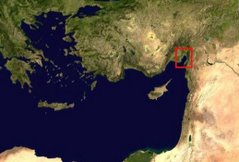
Starts at 4:30am, when we stumble out of bed for a small breakfast – for me, usually a cup of orange juice. We then pack our gear and our second breakfast into the vans and leave our residence at 5:00 for whichever field or hill our glorious leaders have chosen to survey that day.
By 5:15, we have hopefully arrived. The first thing we then do is bum around while our aforementioned leaders decide exactly where we are going to survey. Often we take this opportunity to sit down and catch a nice view of the Turkish countryside:

The early morning on-site meeting must take place because our aerial (well, actually satellite) photos for this region are rather out of date and the fields have changed considerably, owing mostly to a large population increase in and around Iskenderun over the last few decades. Furthermore, we never know which fields will be plowed, planted, or completely overgrown and must adjust our survey coverage accordingly. In a perfect world, the areas surveyed would be chosen according to some highly statistical and very scientific formula, but here this is rather difficult.
In any case, once the field(s) has been chosen we spread apart in preparation for our survey. Distances between walkers vary depending on the width of the field and the size of the survey team, but generally our spread is between 10 and 30 meters.

When everyone is ready, we begin to walk. Surveying is not complicated: each surveyor tries to walk in a straight line, maintaining a consistent distance from those spread to his or her left and right, all the while searching the ground nearby for (most commonly) pottery sherds, roof tiles, or other evidence of ancient human activity. The best terrain for surveying is the plowed field, although we walk through almost anything. This includes the dread fennel – if you look closely in the first picture, you can see Kathleen’s red cap.



Amanda will have a post up soon documenting some of our more impressive finds, but here are a few pictures of some discoveries thus far:

A grindstone:

A small bit of Byzantine mosaic:

When the density of sherds becomes higher than just a few scattered here and there, the team regroups and searches the area, which is called a Site according to this project’s terminology. Here, we bag the pottery found in a separate collection and record the site’s boundaries (never an exact science), among other things. Often, the former is done by forming up in a much tighter line and walking across the site, picking up as many sherds as we see while one person searches for the site perimeter. The most common type of site that we’ve found thus far is the farmstead/villa, but in our survey area we also have a few tells:
Here is Pete marking the boundaries of a farmstead site with his handy GPS. As you see, these sites leave little in the way of structural remains:

After the GPS points are taken, it’s important to take notes describing what the points actually mark:

Here is one example of a tell – note the unnatural shape of the hill, especially its flat top, and the terracing on the lower part of the slope:

Occasionally we do a preliminary pottery sorting in the field. Most of the time, we only keep what are known as diagnostic sherds. That is, handles, rims, bases, and decorated pieces which allow ceramics experts (such as our glorious leaders) to identify the time period in which they were made and used:

Here is a small portion of the pottery found over the course of one day, once it has been washed and sorted:

We pause for breakfast at 9:30, and by this point we are already tired, sweaty, dirty, and hungry, as Rachel is here:

Although the plan is for a 30 minute break, we are usually a bit slower than that. At any rate, once we have eaten we pack up and head back out into the field for another two hours. When on survey, everyone must make sure to constantly drink water in order to avoid dehydration. I myself generally drink at least 3 liters, plus whatever juice there is available at breakfast, and as a team we bring out around 24 1.5 liter bottles of water each day. We finish at noon, when the sun is out in full force and the heat is almost unbearable. After lunch at 12:30, we have a few hours for siesta and then do work in the pottery lab – but that’s the subject of a future post.


No comments:
Post a Comment